
A | B | C | D | E | F | G | H | CH | I | J | K | L | M | N | O | P | Q | R | S | T | U | V | W | X | Y | Z | 0 | 1 | 2 | 3 | 4 | 5 | 6 | 7 | 8 | 9
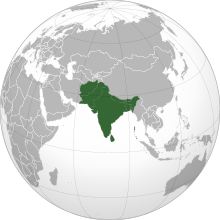 | |
| Area | 5,222,321 km2 (2,016,349 sq mi) |
|---|---|
| Population | 2.04 billion (2024)[1] |
| Population density | 362.3/km2 (938/sq mi) |
| GDP (PPP) | $18.05 trillion (2024)[2] |
| GDP (nominal) | $5.04 trillion (2024)[3] |
| GDP per capita | $2,650 (nominal) (2024) $9,470 (PPP) (2024)[4] |
| HDI | |
| Ethnic groups | Indo-Aryan, Iranian, Dravidian, Sino-Tibetan, Austroasiatic, Turkic etc. |
| Religions | Hinduism, Islam, Christianity, Buddhism, Sikhism, Jainism, Zoroastrianism, Irreligion |
| Demonym | |
| Countries | |
| Dependencies | External (1)
|
| Languages | Official languages (national level) Other official languages (provincial/regional level) |
| Time zones | |
| Internet TLD | .af, .bd, .bt, .in, .io, .lk, .mv, .np, .pk |
| Calling code | Zone 8 & 9 |
| Largest cities | |
| UN M49 code | 034 – Southern Asia142 – Asia001 – World |
South Asia is the southern subregion of Asia, which is defined in both geographical and ethnic-cultural terms. As commonly conceptualized, the modern states of South Asia include Bangladesh, Bhutan, India, the Maldives, Nepal, Pakistan, and Sri Lanka, and with Afghanistan often included, which may otherwise be classified as part of Central Asia.[6][7] South Asia borders East Asia to the northeast, Central Asia to the northwest, West Asia to the west and Southeast Asia to the east. Apart from Southeast Asia, Maritime South Asia is the only subregion of Asia that lies partly within the Southern Hemisphere. The British Indian Ocean Territory and two out of 26 atolls of the Maldives in South Asia lie entirely within the Southern Hemisphere. Topographically, it is dominated by the Indian subcontinent and is bounded by the Indian Ocean in the south, and the Himalayas, Karakoram, and Pamir Mountains in the north.[8]
The South Asian Association for Regional Cooperation (SAARC) is an economic cooperation organization in the region which was established in 1985 and includes all eight nations comprising South Asia.[9] South Asia has a total area of 5.2 million sq.km (2 million sq.mi), which is 10% of the Asian continent.[10] The population of South Asia is estimated to be 1.94 billion or about one-fourth of the world's population, making it both the most populous and the most densely populated geographical region in the world.[11]
In 2022, South Asia had the world's largest populations of Hindus, Muslims, Sikhs, Jains, and Zoroastrians.[12] South Asia alone accounts for 90.47% of Hindus, 95.5% of Sikhs, and 31% of Muslims worldwide, as well as 35 million Christians and 25 million Buddhists.[13][14][15][16]
Definition
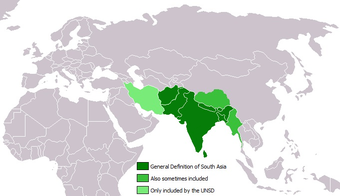
The geographical extent is not clear cut as systemic and foreign policy orientations of its constituents are quite asymmetrical.[18] Beyond the core territories of the Indian Empire (territories of the British Empire which were under the system of British Raj), there is a high degree of variation as to which other countries are included in South Asia.[19][20][21][22] There is no clear boundary – geographical, geopolitical, socio-cultural, economical, or historical – between South Asia and other parts of Asia, especially Southeast Asia and West Asia.[23]
The common definition of South Asia is largely inherited from the administrative boundaries of the Indian Empire,[24] with several exceptions. The current territories of Bangladesh, India, and Pakistan which were the core territories of the British Empire from 1857 to 1947 also form the core territories of South Asia.[25][26] The mountain countries of Nepal and Bhutan, two independent countries that were not under the British Raj but were protectorates of the Empire,[27] and the island countries of Sri Lanka and the Maldives are generally included.[28] By various definitions based on substantially different reasons, the British Indian Ocean Territory and the Tibet Autonomous Region may be included as well.[29][30][31][32][33][34] Myanmar (Burma), a former British colony and now largely considered a part of Southeast Asia, is also sometimes included.[18][20][35] Afghanistan is also included by some sources.[18][20][36][6]

The South Asian Association for Regional Cooperation (SAARC), a contiguous block of countries, started in 1985 with seven countries – Bangladesh, Bhutan, India, the Maldives, Nepal, Pakistan, and Sri Lanka – and admitted Afghanistan as an eighth member in 2007.[38][39] China and Myanmar have also applied for the status of full members of SAARC.[40][41] The South Asia Free Trade Agreement admitted Afghanistan in 2011.[42]
The World Bank and United Nations Children's Fund (UNICEF) recognizes the eight SAARC countries as South Asia,[43][44][45][46] The Hirschman–Herfindahl index of the United Nations Economic and Social Commission for Asia and the Pacific for the region excludes Afghanistan from South Asia.[47] Population Information Network (POPIN) excludes Maldives which is included as a member Pacific POPIN subregional network.[48] The United Nations Statistics Division's scheme of subregions, for statistical purpose,[17] includes Iran along with all eight members of the SAARC as part of Southern Asia.[49]
The boundaries of South Asia vary based on how the region is defined. South Asia's northern, eastern, and western boundaries vary based on definitions used, while the Indian Ocean is the southern periphery. Most of this region rests on the Indian Plate and is isolated from the rest of Asia by mountain barriers.[50][51] Much of the region consists of a peninsula in south-central Asia, rather resembling a diamond which is delineated by the Himalayas on the north, the Hindu Kush in the west, and the Arakanese in the east,[52] and which extends southward into the Indian Ocean with the Arabian Sea to the southwest and the Bay of Bengal to the southeast.[53][54]
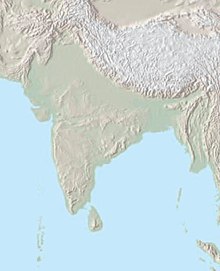
The terms "Indian subcontinent" and "South Asia" are sometimes used interchangeably.[28][53][55][56][57] The Indian subcontinent is largely a geological term referring to the land mass that drifted northeastwards from ancient Gondwana, colliding with the Eurasian plate nearly 55 million years ago, towards the end of Palaeocene. This geological region largely includes Bangladesh, Bhutan, India, Maldives, Nepal, Pakistan, and Sri Lanka.[58] Historians Catherine Asher and Cynthia Talbot state that the term "Indian subcontinent" describes a natural physical landmass in South Asia that has been relatively isolated from the rest of Eurasia.[59]
The use of the term Indian subcontinent began in the British Empire, and has been a term particularly common in its successors.[55] South Asia as the preferred term is particularly common when scholars or officials seek to differentiate this region from East Asia.[60] According to historians Sugata Bose and Ayesha Jalal, the Indian subcontinent has come to be known as South Asia "in more recent and neutral parlance."[56] This "neutral" notion refers to the concerns of Pakistan and Bangladesh, particularly given the recurring conflicts between India and Pakistan, wherein the dominant placement of "India" as a prefix before the subcontinent might offend some political sentiments.[35] However, in Pakistan, the term "South Asia" is considered too India-centric and was banned until 1989 after the death of Zia ul Haq.[61] This region has also been labelled as "India" (in its classical and pre-modern sense) and "Greater India".[35][52]
According to Robert M. Cutler – a scholar of political science at Carleton University,[62] the terms South Asia, Southwest Asia, and Central Asia are distinct, but the confusion and disagreements have arisen due to the geopolitical movement to enlarge these regions into Greater South Asia, Greater Southwest Asia, and Greater Central Asia. The frontier of Greater South Asia, states Cutler, between 2001 and 2006 has been geopolitically extended to eastern Iran and western Afghanistan in the west, and in the north to northeastern Iran, northern Afghanistan, and southern Uzbekistan.[62]
Identification with a South Asian identity was found to be significantly low among respondents in an older two-year survey across Bangladesh, India, Nepal, Pakistan, and Sri Lanka.[63]
History
Pre-history
The history of core South Asia begins with evidence of human activity of Homo sapiens, as long as 75,000 years ago, or with earlier hominids including Homo erectus from about 500,000 years ago.[64] The earliest prehistoric culture have roots in the mesolithic sites as evidenced by the rock paintings of Bhimbetka rock shelters dating to a period of 30,000 BCE or older,[note 3] as well as neolithic times.[note 4]
Ancient era

The Indus Valley civilization, which spread and flourished in the northwestern part of South Asia from c. 3300 to 1300 BCE in present-day Pakistan, Northern India and Afghanistan, was the first major civilization in South Asia.[65] A sophisticated and technologically advanced urban culture developed in the Mature Harappan period, from 2600 to 1900 BCE.[66] According to anthropologist Possehl, the Indus Valley civilization provides a logical, if somewhat arbitrary, starting point for South Asian religions, but these links from the Indus religion to later-day South Asian traditions are subject to scholarly dispute.[67]

The Vedic period, named after the Vedic religion of the Indo-Aryans,[note 5] lasted from c. 1900 to 500 BCE.[69][70] The Indo-Aryans were Indo-European-speaking pastoralists[71] who migrated into north-western India after the collapse of the Indus Valley Civilization.[68][72] Linguistic and archaeological data show a cultural change after 1500 BCE,[68] with the linguistic and religious data clearly showing links with Indo-European languages and religion.[73] By about 1200 BCE, the Vedic culture and agrarian lifestyle were established in the northwest and northern Gangetic plain of South Asia.[71][74][75] Rudimentary state-forms appeared, of which the Kuru-Pañcāla union was the most influential.[76][77] The first recorded state-level society in South Asia existed around 1000 BCE.[71] In this period, states Samuel, emerged the Brahmana and Aranyaka layers of Vedic texts, which merged into the earliest Upanishads.[78] These texts began to ask the meaning of a ritual, adding increasing levels of philosophical and metaphysical speculation,[78] or "Hindu synthesis".[79]
Increasing urbanisation of South Asia between 800 and 400 BCE, and possibly the spread of urban diseases, contributed to the rise of ascetic movements and of new ideas which challenged the orthodox Brahmanism.[80][failed verification] These ideas led to Sramana movements, of which Mahavira (c. 549–477 BCE), proponent of Jainism, and Buddha (c. 563 – c. 483), founder of Buddhism, was the most prominent icons.[81]
The Greek army led by Alexander the Great stayed in the Hindu Kush region of South Asia for several years and then later moved into the Indus valley region. Later, the Maurya Empire extended over much of South Asia in the 3rd century BCE. Buddhism spread beyond south Asia, through northwest into Central Asia. The Bamiyan Buddhas of Afghanistan and the edicts of Aśoka suggest that the Buddhist monks spread Buddhism (Dharma) in eastern provinces of the Seleucid Empire, and possibly even farther into West Asia.[82][83][84] The Theravada school spread south from India in the 3rd century BCE, to Sri Lanka, later to Southeast Asia.[85] Buddhism, by the last centuries of the 1st millennium BCE, was prominent in the Himalayan region, Gandhara, Hindu Kush region and Bactria.[86][87][88]
From about 500 BCE through about 300 CE, the Vedic-Brahmanic synthesis or "Hindu synthesis" continued.[79] Classical Hindu and Sramanic (particularly Buddhist) ideas spread within South Asia, as well as outside South Asia.[89][90][91] The Gupta Empire ruled over a large part of the region between the 4th and 7th centuries, a period that saw the construction of major temples, monasteries and universities such as the Nalanda.[92][93][94] During this era, and through the 10th century, numerous cave monasteries and temples such as the Ajanta Caves, Badami cave temples and Ellora Caves were built in South Asia.[95][96][97]
Medieval era

Islam came as a political power in the fringe of South Asia in 8th century CE when the Arab general Muhammad bin Qasim conquered Sindh, and Multan in Southern Punjab, in modern-day Pakistan.[98] By 962 CE, Hindu and Buddhist kingdoms in South Asia were under a wave of raids from Muslim armies from Central Asia.[99] Among them was Mahmud of Ghazni, who raided and plundered kingdoms in north India from east of the Indus river to west of Yamuna river seventeen times between 997 and 1030.[100] Mahmud of Ghazni raided the treasuries but retracted each time, only extending Islamic rule into western Punjab.[101][102]

The wave of raids on north Indian and western Indian kingdoms by Muslim warlords continued after Mahmud of Ghazni, plundering and looting these kingdoms.[103] The raids did not establish or extend permanent boundaries of their Islamic kingdoms. The Ghurid Sultan Mu'izz al-Din Muhammad began a systematic war of expansion into North India in 1173.[104] He sought to carve out a principality for himself by expanding the Islamic world,[100][105] and thus laid the foundation for the Muslim kingdom that became the Delhi Sultanate.[100] Some historians chronicle the Delhi Sultanate from 1192 due to the presence and geographical claims of Mu'izz al-Din in South Asia by that time.[106]
The Delhi Sultanate covered varying parts of South Asia and was ruled by a series of dynasties: Mamluk, Khalji, Tughlaq, Sayyid and Lodi dynasties. Muhammad bin Tughlaq came to power in 1325, launched a war of expansion and the Delhi Sultanate reached it largest geographical reach over the South Asian region during his 26-year rule.[107] A Sunni Sultan, Muhammad bin Tughlaq persecuted non-Muslims such as Hindus, as well as non-Sunni Muslims such as Shia and Mahdi sects.[108][109][110]
Revolts against the Delhi Sultanate sprang up in many parts of South Asia during the 14th century.[citation needed] In the northeast, the Bengal Sultanate became independent in 1346 CE. It remained in power through the early 16th century. The state religion of the sultanate was Islam.[111][112] In South India, the Hindu Vijayanagara Empire came to power in 1336 and persisted until the middle of the 16th century. It was ultimately defeated and destroyed by an alliance of Muslim Deccan sultanates at the battle of Talikota.[113][114]
About 1526, the Punjab governor Dawlat Khan Lodī reached out to the Mughal Babur and invited him to attack the Delhi Sultanate. Babur defeated and killed Ibrahim Lodi in the Battle of Panipat in 1526. The death of Ibrahim Lodi ended the Delhi Sultanate, and the Mughal Empire replaced it.[115]
Modern era

The modern history period of South Asia, that is 16th-century onwards, witnessed the establishment of the Mughal empire, with Sunni Islam theology. The first ruler was Babur had Turco-Mongol roots and his realm included the northwestern and Indo-Gangetic Plain regions of South Asia. The southern and northeastern regions of South Asia were largely under Hindu kings such as those of Vijayanagara Empire and Ahom kingdom,[116] with some regions such as parts of modern Telangana and Andhra Pradesh under local Sultanates namely Deccan sultanates.[117][118]
The Mughal Empire continued its wars of expansion after Babur's death. With the fall of the Rajput kingdoms and Vijayanagara, its boundaries encompassed almost the entirety of the Indian subcontinent.[119] The Mughal Empire was marked by a period of artistic exchanges and a Central Asian and South Asian architecture synthesis, with remarkable buildings such as the Taj Mahal.[120][118][121]
However, this time also marked an extended period of religious persecution.[122] Two of the religious leaders of Sikhism, Guru Arjan and Guru Tegh Bahadur were arrested under orders of the Mughal emperors after their revolts and were executed when they refused to convert to Islam.[123][124][125] Religious taxes on non-Muslims called jizya were imposed. Buddhist, Hindu and Sikh temples were desecrated. However, not all Muslim rulers persecuted non-Muslims. Akbar, a Mughal ruler for example, sought religious tolerance and abolished jizya.[126][127][128][129]
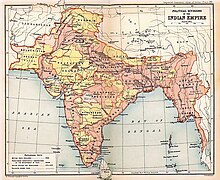
After the death of Aurangzeb and the collapse of the Mughal Empire, which marks the beginning of modern India, in the early 18th century, it provided opportunities for the Marathas, Sikhs, Mysoreans and Nawabs of Bengal to exercise control over large regions of the Indian subcontinent.[130][131] By the mid-18th century, India was a major proto-industrializing region.[132][118]
Maritime trading between South Asia and European merchants began after the Portuguese explorer Vasco da Gama returned to Europe. British, French, Portuguese colonial interests struck treaties with these rulers and established their trading ports. In northwestern South Asia, a large region was consolidated into the Sikh Empire by Ranjit Singh.[133][134] After the defeat of the Nawab of Bengal and Tipu Sultan and his French allies, British traders went on to dominate much of South Asia through divide-and-rule tactics by the early 19th century. The region experienced significant de-industrialisation in its first few decades of British rule.[135] Control over the subcontinent was then transferred to the British government after the Indian Rebellion of 1857, with the British cracking down to some extent afterwards.[136]
An increase of famines and extreme poverty characterised the colonial period, though railways built with British technology eventually provided crucial famine relief by increasing food distribution throughout India.[137][135] Millions of South Asians began to migrate throughout the world, impelled by the economic/labour needs and opportunities presented by the British Empire.[138][139][140] The introduction of Western political thought inspired a growing Indian intellectual movement, and so by the 20th century, British rule began to be challenged by the Indian National Congress, which sought full independence under the leadership of Mahatma Gandhi.[141][142]
Britain, under pressure from Indian freedom fighters, increasingly gave self-rule to British India. By the 1940s, two rival camps emerged among independence activists: those who favored a separate nation for Indian Muslims, and those who wanted a united India. As World War II raged, over 2 million Indians fought for Britain;[143] by the end of the war, Britain was greatly weakened, and thus decided to grant independence to the vast majority of South Asians in 1947,[144][145] though this coincided with the partition of India into a Hindu-majority India and a Muslim-majority Pakistan, which resulted in significant displacement and violence and hardened religious divides in the region.[146]
Contemporary era
In 1947, the newly independent India and Pakistan had to decide how to deal with the hundreds of princely states that controlled much of the subcontinent, as well as what to do with the remaining European (non-British) colonies.[147] A combination of referendums, military action, and negotiated accessions took place in rapid succession, leading to the political integration of the vast majority of India and Pakistan within a few years.[148][149]

India and Pakistan clashed several times in the decades after Independence, with disputes over Kashmir playing a significant role.[150] In 1971, the eastern half of Pakistan seceded with help from India and became the People's Republic of Bangladesh after the traumatic Bangladesh Liberation War.[151] This, along with India and Pakistan gaining nuclear weapons soon afterwards, increased tensions between the two countries.[152] The Cold War decades also contributed to the divide, as Pakistan aligned with the West and India with the Soviet Union;[153][154] other factors include the time period after the 1962 India-China War, which saw India and China move apart while Pakistan and China built closer relations.[155]
Pakistan has been beset with terrorism, economic issues and military dominance of its government since Independence,[156] with none of its Prime Ministers having completed a full 5-year term in office.[157] India has grown significantly,[158] having slashed its rate of extreme poverty to below 20%.[159] Bangladesh, having struggled greatly for decades due to conflict with and economic exploitation by Pakistan,[160][161] is now one of the fastest-growing countries in the region, beating India in terms of GDP per capita.[162][163] Afghanistan has gone through several invasions and Islamist regimes, with many of its refugees having gone to Pakistan and other parts of South Asia and bringing back cultural influences such as cricket.[164][165] Religious nationalism has grown across the region,[166][167] with persecution causing millions of Hindus and Christians to flee Pakistan and Bangladesh,[168][169] and Hindu nationalism having grown in India with the election of the Bharatiya Janata Party in 2014.[170]
A recent phenomenon has been that of India and China fighting on their border, as well as vying for dominance of South Asia, with China partnering with Pakistan and using its superior economy to attract countries surrounding India, while America and other countries have strengthened ties with India to counter China in the broader Indo-Pacific.[171][172]
Geography
According to Saul Cohen, early colonial era strategists treated South Asia with East Asia, but in reality, the South Asia region excluding Afghanistan is a distinct geopolitical region separated from other nearby geostrategic realms, one that is geographically diverse.[173] The region is home to a variety of geographical features, such as glaciers, rainforests, valleys, deserts, and grasslands that are typical of much larger continents. It is surrounded by three water bodies – the Bay of Bengal, the Indian Ocean and the Arabian Sea – and has acutely varied climate zones. The tip of the Indian Peninsula had the highest quality pearls.[174]
Indian Plate
Most of this region is resting on the Indian Plate, the northerly portion of the Indo-Australian Plate, separated from the rest of the Eurasian Plate. The Indian Plate includes most of South Asia, forming a land mass which extends from the Himalayas into a portion of the basin under the Indian Ocean, including parts of South China and Eastern Indonesia, as well as Kunlun and Karakoram ranges,[175][176] and extending up to but not including Ladakh, Kohistan, the Hindu Kush range, and Balochistan.[177][178][179] It may be noted that geophysically the Yarlung Tsangpo River in Tibet is situated at the outside the border of the regional structure, while the Pamir Mountains in Tajikistan are situated inside that border.[180]
The Indian subcontinent formerly formed part of the supercontinent Gondwana, before rifting away during the Cretaceous period and colliding with the Eurasian Plate about 50–55 million years ago and giving birth to the Himalayan range and the Tibetan plateau. It is the peninsular region south of the Himalayas and Kuen Lun mountain ranges and east of the Indus River and the Iranian Plateau, extending southward into the Indian Ocean between the Arabian Sea (to the southwest) and the Bay of Bengal (to the southeast).
Climate
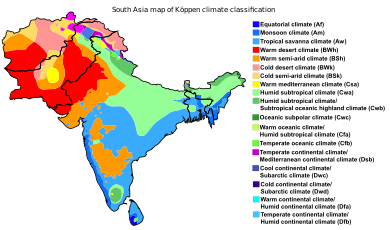
The climate of this vast region varies considerably from area to area from tropical monsoon in the south to temperate in the north. The variety is influenced by not only the altitude but also by factors such as proximity to the seacoast and the seasonal impact of the monsoons. Southern parts are mostly hot in summers and receive rain during monsoon periods. The northern belt of Indo-Gangetic plains also is hot in summer, but cooler in winter. The mountainous north is colder and receives snowfall at higher altitudes of Himalayan ranges.
As the Himalayas block the north-Asian bitter cold winds, the temperatures are considerably moderate in the plains down below. For the most part, the climate of the region is called the monsoon climate, which keeps the region humid during summer and dry during winter, and favours the cultivation of jute, tea, rice, and various vegetables in this region.
South Asia is largely divided into four broad climate zones:[182]
- The northern Indian edge and northern Pakistani uplands have a dry subtropical continental climate
- The far south of India and southwest Sri Lanka have an equatorial climate
- Most of the peninsula has a tropical climate with variations:
- Hot subtropical climate in northwest India
- Cool winter hot tropical climate in Bangladesh
- Tropical semi-arid climate in the center
- The Himalayas and most of the Hindu Kush have an Alpine climate
Maximum relative humidity of over 80% has been recorded in Khasi and Jaintia Hills and Sri Lanka, while the area adjustment to Pakistan and western India records lower than 20%–30%.[182] Climate of South Asia is largely characterized by monsoons. South Asia depends critically on monsoon rainfall.[183] Two monsoon systems exist in the region:[184]
- The summer monsoon: Wind blows from the southwest to most parts of the region. It accounts for 70%–90% of the annual precipitation.
- The winter monsoon: Wind blows from the northeast. Dominant in Sri Lanka and Maldives.
The warmest period of the year precedes the monsoon season (March to mid June). In the summer the low pressures are centered over the Indus-Gangetic Plain and high wind from the Indian Ocean blows towards the center. The monsoons are the second coolest season of the year because of high humidity and cloud covering. But, at the beginning of June, the jetstreams vanish above the Tibetan Plateau, low pressure over the Indus Valley deepens and the Intertropical Convergence Zone (ITCZ) moves in. The change is violent. Moderately vigorous monsoon depressions form in the Bay of Bengal and make landfall from June to September.[182]
Climate change

South Asian countries are expected to experience more flooding in the future as the monsoon pattern intensifies.[186]: 1459 Across Asia as a whole, 100-year extremes in vapor transport (directly related to extreme precipitation) would become 2.6 times more frequent under 1.5 °C (2.7 °F) of global warming, yet 3.9 and 7.5 times more frequent under 2 °C (3.6 °F) and 3 °C (5.4 °F). In parts of South Asia, they could become up to 15 times more frequent.[185] At the same time, up to two-thirds of glacier ice in the Hindu Kush region may melt by 2100 under high warming, and these glaciers feed the water basin of over 220 million people.[186]: 1487 As glacier meltwater flow diminishes after 2050, Hydropower generation would become less predictable and reliable, while agriculture would become more reliant on the intensified monsoon than ever before.[187][188][189] Around 2050, people living in the Ganges and Indus river basins (where up to 60% of non-monsoon irrigation comes from the glaciers[190]) may be faced with severe water scarcity due to both climate and socioeconomic reasons.[186]: 1486
By 2030, major Indian cities such as Mumbai, Kolkata, Cuttack and Kochi are expected to end up with much of their territory below the tide level.[191] In Mumbai alone, failing to adapt to this would result in damages of US$112–162 billion by 2050, which would nearly triple by 2070.[186] Sea level rise in Bangladesh will displace 0.9–2.1 million people by 2050 and may force the relocation of up to one third of power plants by 2030.[186] Food security will become more uneven, and some South Asian countries could experience significant social impacts from global food price volatility.[186]: 1494 Infectious diarrhoea mortality and dengue fever incidence is also likely to increase across South Asia.[186]: 1508 Parts of South Asia would also reach "critical health thresholds" for heat stress under all but the lowest-emission climate change scenarios.[186]: 1465 Under the high-emission scenario, 40 million people (nearly 2% of the South Asian population) may be driven to internal migration by 2050 due to climate change.[186]: 1469
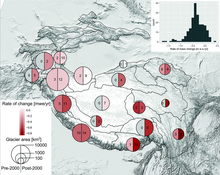
India is estimated to have the world's highest social cost of carbon - meaning that it experiences the greatest impact from greenhouse gas emissions.[192] Other estimates describe Bangladesh as the country most likely to be the worst-affected.[193][194][195] In the 2017 edition of Germanwatch's Climate Risk Index, Bangladesh and Pakistan ranked sixth and seventh respectively as the countries most affected by climate change in the period from 1996 to 2015, while India ranked fourth among the list of countries most affected by climate change in 2015.[196] Some research suggests that South Asia as a whole would lose 2% of its GDP to climate change by 2050, while these losses would approach 9% by the end of the century under the most intense climate change scenario.[186]: 1468
Regions
Land and water area
This list includes dependent territories within their sovereign states (including uninhabited territories), but does not include claims on Antarctica. EEZ+TIA is exclusive economic zone (EEZ) plus total internal area (TIA) which includes land and internal waters.
| Country | Area in km2 | EEZ | Shelf | EEZ+TIA |
|---|---|---|---|---|
| 652,864 | 0 | 0 | 652,864 | |
| 148,460 | 86,392 | 66,438 | 230,390 | |
| 38,394 | 0 | 0 | 38,394 | |
| 3,287,263 | 2,305,143 | 402,996 | 5,592,406 | |
| 147,181 | 0 | 0 | 147,181 | |
| 298 | 923,322 | 34,538 | 923,622 | |
| 881,913 | 290,000 | 51,383 | 1,117,911 | |
| 65,610 | 532,619 | 32,453 | 598,229 | |
| Total | 5,221,093 | 4,137,476 | 587,808 | 9,300,997 |
Society
Population
The population of South Asia is about 1.938 billion which makes it the most populated region in the world.[197] It is socially very mixed, consisting of many language groups and religions, and social practices in one region that are vastly different from those in another.[198]
| Country | Population in thousands | % of South Asia | % of world[200] | Density (per km2) | Population growth rate[201] | Population projection (in thousands)[199][1] | ||||||||
|---|---|---|---|---|---|---|---|---|---|---|---|---|---|---|
| 2005–10 | 2010–15 | 2015–20 | 1950 | 1975 | 2000 | 2025 | 2050 | 2075 | 2100 | |||||
| 42,240 | 2.17% | 0.525% | 61.8 | 2.78 | 3.16 | 2.41 | 7,752 | 12,689 | 20,779 | 44,516 | 74,075 | 98,732 | 110,855 | |
| 172,954 | 8.92% | 2.15% | Zdroj:https://en.wikipedia.org?pojem=South_Asian_history||||||||||||
